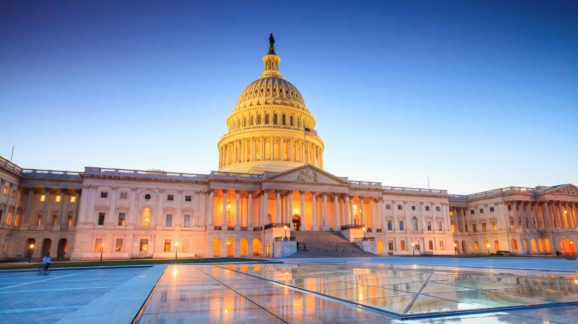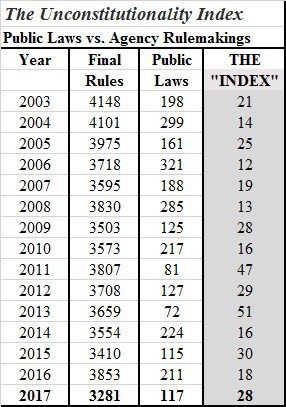The 2018 Unconstitutionality Index: 28 Federal Agency Rules for Every Law Congress Passes

 Even when an administration tries to cut regulation, the number of rules from hundreds of federal agencies will vastly outstrip the number of laws Congress passes.
Even when an administration tries to cut regulation, the number of rules from hundreds of federal agencies will vastly outstrip the number of laws Congress passes.
That’s true even for Trump’s first calendar year. Let’s look at where we are.
The second half of the 115th Congress gets underway this week, in the wake of the Trump administration’s touting notable regulatory rollback achievements of 2017 in a “Two-for-One and Regulatory Cost Caps” status report. It’s all available on the Unified Agenda web page.
Let it be known that Bloomberg News wasn’t impressed, however, intoning that Trump “claims credit for some regulatory actions begun under Obama,” and that the “deregulatory list ranges from bird feathers to grizzlies.”
In any case, after Donald Trump took the oath of office last January, Congress set about rolling back some of president Barack Obama’s rules and regulations issued during the final months of his term. Congress used the resolution of disapproval process established by the Congressional Review Act (CRA).
Hundreds of rules were eligible, but just 15 were eliminated. The entrenched regulatory enterprise has enormous staying power with which Congress has yet to grapple. Still, 2017 saw the most dramatic usage of the CRA ever.
Trump promised to freeze federal regulation and to aggressively eliminate rules, and did about as well as could be expected given the need to act alone apart from the CRA. In the Unified Agenda, where agencies define their priorities, the administration announced delay or withdrawal of 1,579 Obama rules that were in the pipeline. While the House has done its job by passing major reforms like the Regulatory Accountability Act, no regulatory reform bill apart from CRA resolutions has gotten through the Senate.
As for new final rules, the administration has largely held regulatory agencies in check by eliminating 67 in-force measures, and issuing only a claimed three (I count 15, though) significant rules.
By this reckoning the 2-for-1 goal was bested; 22-1 instead.
Interestingly, nine of the 67 eliminations were guidance documents or notices (listed here). Regulatory dark matter is an increasingly worrisome phenomenon.
With that backdrop, let’s look at laws versus rules.
Congress’s Laws
In 2017, Congress passed and the president signed “only” 92 laws according to the tally on the Government Publishing Office’s archive of public laws, complete through December 12th, my preferred resource. Meanwhile the Govtrack legislative search yields five more through December 22, for a total of 97.
Another 20 laws achieved House and Senate passage before recess between the 19th and 22nd, all with 93 or 94 percent prognosis of being signed by Trump in the coming days.
So Congress passed, by this preliminary count, 117 laws in 2017.
These measures range from the 115th Congress’s first law to get tech talent hired in the federal government on January 20, to the tax bill, H.R. 1, signed by Trump December 22.
Among such annual tallies one finds legislative initiatives ranging from naming post offices and community centers after politicians and dignitaries, to major reauthorizations of agencies like the Food and Drug Administration.
Per usual, the federal bureaucracy was far busier making laws than Congress was, however.
Agencies’ Rules
During calendar year 2016 under Barack Obama, agencies issued a record-setting Federal Register of 97,110 pages (which after blanks and skips were eliminated, settled at a still-record 95,894 pages) Within those pages, agencies issued 3,853 rules and regulations.
The 2017 calendar year Federal Register ended at 61,950 pages. Within those pages, agencies issued a total of 3,281 rules in 2017, 572 below Obama’s final-year tally. Note that 207 of these were Obama rules issued from January 1 through January 20, Trump’s inauguration day.
Note also that these page and rule counts are the preliminary tallies from the National Archives’ Federal Register database; a final reckoning a tad higher or lower will be issued within a couple months.
Rules have numbered well over 3,000 per year for decades. Trump, in his status report, noted adding only three “significant” rules. But there are hundreds upon hundreds of rules that for better (like laws that name community centers) or worse do not rise to the level of “significance” targeted in the 2-for-1 executive order campaign. Federal Aviation Administration airworthiness directives numbering in the hundreds are a classic example.
The Unconstitutionality Index
Now, obviously in any given year, the specific rules agencies issue are not likely to be tied to the laws enacted that same year.
Nonetheless, in terms of flow, federal agencies in 2017 issued 28 rules and regulations for every law Congress passed. (It had been 18 the year before.)
I like to call this ratio The Unconstitutionality Index; it’s the multiple of agency rules over the number of laws from our elected Congress.
The chart below depicts the Index going back to 2003 (you can go back earlier in the Ten Thousand Commandments roundup in Historical Tables, Part J).

As we’ve described before, there’s no pattern to any of this, since the numerators and denominators can vary widely. For example, there had been 81 laws in 2011, and a multiple as high as 47—and a multiple as low as 12 in 2006. The multiple can be higher with fewer laws, or with more regulations, holding the other constant.
The point, though, is that the unelected personnel of agencies do the bulk of lawmaking in America, not Congress—no matter the party in power.
For what it’s worth, during Bush’s eight years, the multiple averaged 20, while Obama’s eight averaged 29.
In addition, Trump’s aim is eliminating rules, but alas, eliminating a rule requires issuing another rule.
Still, as far as the Index is concerned, whether you’re adding rules or trying to take them away, you’re still looking at unelected officials making law. One might say the march toward civilization and human liberty is a march toward not doing that anymore.
Until then, the ratchet largely goes only one way and the administrative state grows, at least until major reform of occurs. Legislators of both parties relinquished their constitutional authority and tolerate the administrative state.
A major change that could alter future indices is that the Trump administration, for the first time, has incorporated a “Deregulatory” search option under “EO 13771 Designation” in the Unified Agenda database. In other words, I could have pulled the rules Trump eliminated and other agency deregulatory actions out of the agency count. This new disclosure is a very important step, but “lesser” deregulatory actions also should be searchable, and capable of being easily isolated for inspection.
Now, having said all this, there are hundreds of agency guidance documents and various forms of regulatory dark matter (guidance documents, memoranda, notices, letters, and other proclamations), that carry the lawmaking of the unelected to even greater levels, and would send the index higher if included.
Congress, and the Trump administration through a new executive order, both should more explicitly recognize and restrain guidance. As it stands, lawmaking without the involvement of elected representatives goes well beyond what the Index captures.
It remains up to the 115th Congress, and probably the 116th Congress, to develop a regulatory liberalization agenda with the president. The White House can’t (and shouldn’t) do all of it alone.
Happy 2018.